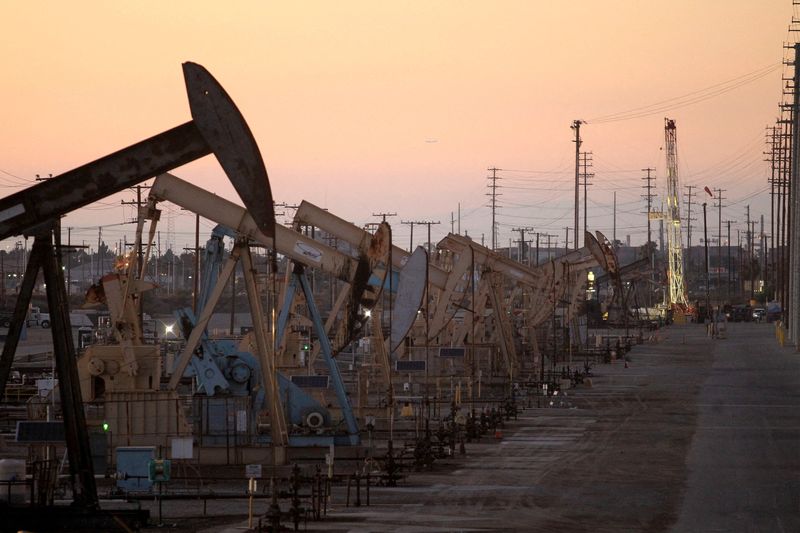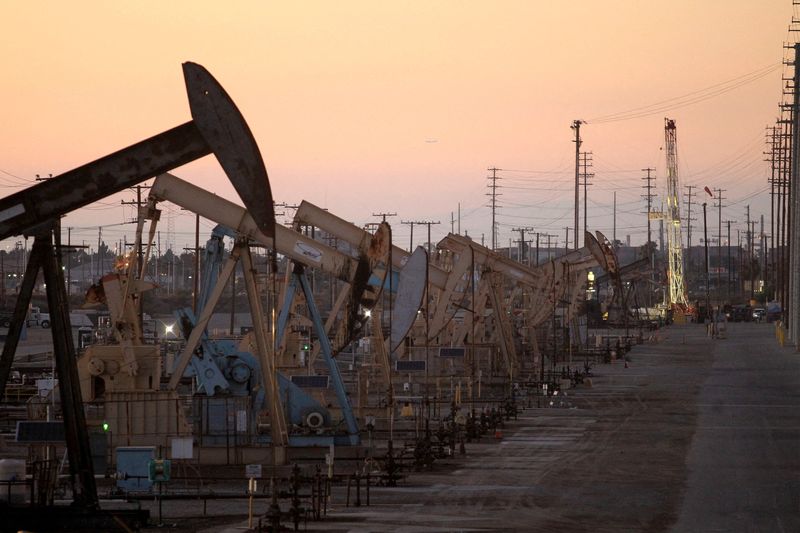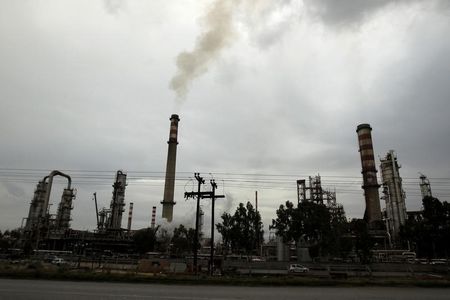Commodities
Oil prices settle slightly down after US boosts crude output forecast


© Reuters. FILE PHOTO: Oil rig pumpjacks, also known as thirsty birds, extract crude from the Wilmington Field oil deposits area near Long Beach, California July 30, 2013. REUTERS/David McNew//File Photo
By Nicole Jao
NEW YORK (Reuters) -Oil prices dipped on Tuesday, settling slightly lower after a higher-than-expected forecast for oil production and bearish economic data, but persistent geopolitical tensions limited declines.
futures for May delivery settled 29 cents lower at $81.92 a barrel. The April U.S. West Texas Intermediate (WTI) crude contract ended 37 cents lower at $77.56.
U.S. consumer prices increased solidly in February, the U.S. Bureau of Labor Statistics said, pinning nagging inflation largely on higher costs for gasoline and shelter.
“This does show a second month of an increase,” said Tim Snyder, an economist at Matador Economics, noting the numbers were still within expectations. “Consensus in the markets says the Fed will not move to lower rates until June,” he added.
On Tuesday, OPEC stuck to its forecast for relatively strong growth in global oil demand in 2024 and 2025, and further raised its economic growth forecast for this year saying there was more room for improvement.
On the supply side, U.S. Energy Information Administration (EIA) raised its 2024 outlook for domestic oil output growth by 260,000 barrels per day to 13.19 million barrels, versus a previously forecast rise of 170,000 bpd.
The boosted forecast could be due to higher assumed oil prices, said UBS analyst Giovanni Staunovo.
U.S. crude stocks fell 5.521 million barrels in the week ended Mar. 8, according to market sources citing American Petroleum Institute figures on Tuesday.[API/S]
Official U.S. government data is due on Wednesday.
Last week, economic data from China, the world’s biggest oil buyer, suggested softening demand even as crude imports increased in the first two months of the year from a year earlier.
“Bearish demand sentiment and growing non-OPEC supply leave little room for the market to be bullish on oil prices at this time,” said Serena Huang, head of APAC analysis at Vortexa.
GEOPOLITICAL TENSIONS
Hopes of a ceasefire in Israel’s war against Hamas have faded, with negotiations deadlocked in Cairo while Israel and Lebanon’s Hezbollah continue to exchange fire.
Though the Gaza conflict has not led to significant oil supply disruptions, Yemen’s Iran-aligned Houthis have been attacking ships in the Red Sea and Gulf of Aden since November in solidarity with Palestinians.
Airstrikes attributed to a U.S.-British coalition hit port cities and small towns in western Yemen on Monday and the Houthis said on Tuesday that they had fired missiles at what they described as a U.S. ship in the Red Sea.
Traders are becoming inured to such attacks, said John Evans at oil broker PVM.
“The inventory of oil that might be affected is not lost, it is just delayed – and with the new shipping times being part of the new norm, ‘delayed’ will eventually not be applicable,” he said.
In Russia, the world’s second-largest oil exporter, a Ukrainian attack on energy facilities set ablaze Lukoil’s NORSI refinery.
Commodities
Gold and silver to continue to appreciate – Julius Baer

Investing.com – With another day of gains in and futures, the Swiss group Julius Baer has decided to change its outlook on commodities to constructive. The group now believes that both metals have the potential for further increases, as stated in a note sent to clients and the market on Friday morning.
The group mentioned that, in addition to U.S. monetary policy, the gold market is still dominated by Asia. “We have to recognize that the region’s willingness to pay for gold as a hedge against economic and geopolitical risks appears even greater than we expected,” said Carsten Menke, head of next-generation research at Julius Baer.
Weaker-than-expected U.S. economic data have revived hopes for interest rate cuts by the Federal Reserve (Fed, the U.S. central bank), boosting gold and silver prices. This could “be the missing incentive for safe-haven seekers in the Western world to return to the markets,” he added.
Central Bank Purchases in Focus
Central banks have been buying gold more for geopolitical reasons than economic ones, according to Julius Baer. In China, for example, there is a desire to reduce dependence on the U.S. dollar – important for avoiding potential sanctions.
The People’s Bank of China is believed to be responsible for at least 30% to 50% of all central bank purchases over the past two years. Although it shows signs of being price-sensitive, “its willingness to pay has increased as gold prices rise,” notes Julius Baer. It is expected that other monetary authorities will follow the same steps, moving away from the U.S. dollar.
remove ads
.
***
Want to leverage your strategies with stocks of companies related to commodities?
Then come to InvestingPro! By becoming a member of InvestingPro, you get access to features such as:
- ProPicks: AI-managed stock portfolios with proven results.
- ProTips: Quick and straightforward tips to simplify complex financial information.
- Advanced stock filter: Find the stocks that best meet your expectations based on hundreds of financial metrics.
- Turbo navigation: Investing.com pages load much faster, without any ads.
- Institutional-level financial data for thousands of stocks: Ideal for investors who want to conduct their own detailed evaluations.
- And many more services to be added soon!
Enjoy all this with an extra discount on 1 or 2-year Pro and Pro+ plans. Enter the code INVESTIR and enjoy!
Commodities
Goldman Sachs discusses what’s next for natural gas prices

Over the past three weeks, US prices have surged 30% to above $2.50 per million British thermal units (mm/BTU), fueled by production declines and increased feedgas demand for liquified natural gas (LNG) exports.
Moreover, recent producer cuts, maintenance events, and Freeport LNG’s normalization of gas demand post-outage have contributed to this rise. Cheniere’s announcement of no heavy maintenance for its liquefaction trains this year also supports higher prices.
In a Thursday note, Goldman Sachs strategists said the return of gas prices above $2/mmBtu aligns with their expectations, as production curtailments “would ultimately lead to lower storage congestion risks for this summer.”
“That said, we see only limited further upside from current levels, with stronger gas prices risking a return of congestion concerns,” they added.
Goldman notes that prices above $2/mmBtu reduce gas competitiveness compared to coal, with a $0.50/mmBtu increase potentially cutting gas demand by 1 billion cubic feet per day (Bcf/d), especially in shoulder months.
Moreover, higher prices may prompt the restart of previously shut-in wells. EQT (ST:), the largest producer in the Appalachia region, indicated it would resume production if prices sustainably exceed $1.50/mmBtu. And while Appalachia prices haven’t risen as much as NYMEX, the local hub has averaged $1.44/mmBtu month-to-date, up 10¢ from last month, strategists highlighted.
Elsewhere, European gas prices have also risen this summer, though less sharply than in the US.
Title Transfer Facility (TTF) prices increased 18% over the past three months to around 30 euros per megawatt-hour (MWh), holding steady in May.
remove ads
.
However, unlike the US market, this rally lacks fundamental support, with Northwest (NW) European gas storage at record-high levels, Goldman strategists pointed out.
“To be sure, NW European LNG imports have remained weak relative to last year – and are likely to get weaker in the coming weeks owing to a seasonal decline in global LNG production, exacerbated by outages at Australia’s Gorgon export project,” they said.
“Going forward, we expect healthy non-European demand for LNG to continue to incentivize a decline in European LNG imports vs last year,” they continued.
Commodities
Gold prices trim some weekly gains on tempered rate cut hopes

Investing.com– Gold prices fell slightly on Friday, trimming some of their gains for the week as comments from a slew of Federal Reserve officials offered a more sobering outlook on interest rate cuts.
The yellow metal had risen to nearly $2,400 an ounce this week in the immediate aftermath of some soft U.S. economic readings. But it pulled back from these levels on Thursday and Friday.
steadied at $2,377.40 an ounce, while expiring in June fell slightly to $2,381.10 an ounce by 00:19 ET (04:19 GMT).
Gold retreats as Fed officials downplay rate cuts, but weekly gains due
The yellow metal fell on Thursday after a string of Fed officials cautioned against bets on immediate reductions in interest rates.
Several members of the central bank’s rate setting committee said the central bank will need much more convincing that inflation was coming down beyond a marginally soft inflation reading for April.
This saw traders begin pricing out some expectations for a rate cut in September. The and also rebounded from earlier losses this week.
Still, some softer-than-expected readings put gold on course for a 0.7% weekly gain.
The yellow metal was also in sight of a record high of above $2,430 an ounce, although it appeared unlikely the level would be met in the near-term.
Other precious metals retreated on Friday, but were set for bumper weekly gains. fell 0.2% but were trading up 6.2% for the week, while fell 0.4% but were up 4.5% this week.
remove ads
.
Copper mixed amid middling China cues
Among industrial metals, one-month copper futures tumbled from two-year highs tracking middling economic data. But three-month copper futures pushed higher and were set for a stellar week as markets bet on tighter supplies and an eventual demand recovery in the coming months.
on the London Metal Exchange rose 0.6% to $10,445.0 a ton, while rose 0.3% to $4.8935 a pound.
Data from China on Friday painted a mixed picture of the economy. While grew more than expected, growth slowed and shrank at an accelerated pace. Growth in Chinese also slowed.
The readings presented a muddled outlook for the world’s biggest copper importer, as it rolled out more stimulus measures to shore up growth.
Three-month copper futures gained on the prospect of a demand recovery, and were up nearly 4% this week. They were also at two-year highs.

 Forex2 years ago
Forex2 years agoForex Today: the dollar is gaining strength amid gloomy sentiment at the start of the Fed’s week

 Forex2 years ago
Forex2 years agoHow is the Australian dollar doing today?

 Forex1 year ago
Forex1 year agoUnbiased review of Pocket Option broker

 Forex2 years ago
Forex2 years agoDollar to pound sterling exchange rate today: Pound plummeted to its lowest since 1985

 Cryptocurrency2 years ago
Cryptocurrency2 years agoWhat happened in the crypto market – current events today

 World2 years ago
World2 years agoWhy are modern video games an art form?

 Stock Markets2 years ago
Stock Markets2 years agoMorgan Stanley: bear market rally to continue

 Economy2 years ago
Economy2 years agoCrude oil tankers double in price due to EU anti-Russian sanctions

































